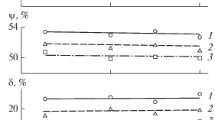Abstract
The methods of metallography, scanning electron microscopy, microscopic x-ray spectral analysis, x-ray diffraction analysis, atomic force microscopy, x-ray photoelectron spectroscopy, Auger spectroscopy, scanning profilometry, and measurement of microhardness are used to study the structure of the surface of specimens of “ steel-steel” tribotechnical mating parts operating in lubricants alloyed with nanopowders of copper, zinc, and brass. The friction factors and wear are determined for the lubricants. The strained state of the surface layers formed under friction in media with nanopowders is considered.
Similar content being viewed by others

References
D. A. Rigney, “Transfer, mixing and associated chemical and mechanical processes during sliding of ductile materials,” Wear, 245, 1–9 (2000).
J. L. Young, D. Kuhlmann-Wilsdorf, and R. Hull, “The generation of mechanically mixed layers (MML) during sliding contact and the effects of lubricant thereon,” Wear, 246, 74–90 (2000).
A. Kapoor and F. J. Franklin, “Tribological layers and the wear of ductile materials,” Wear, 245, 204–215 (2000).
S. N. Komarov, V. F. Pichugin, and N. N. Komarova, “Metal cladding lubricants for steel-steel friction pairs,” in: Life of Rubbing Machine Parts, Issue 5 [in Russian], Mashinostroenie, Moscow (1990), pp. 70–85.
I. V. Frishberg, L. V. Zolotukhina, V. V. Kharlamov, et al., “Reconditioning of damaged surface in operation of a friction pair in the presence of ultrafine powder of copper alloy,” Metalloved. Term. Obrab. Met., No. 7, 21–23 (2000).
S. Tarasov, A. Kolubaev, S. Belyaev, M. Lerner, and F. Tepper, “Study of friction reduction by nanocopper additive to motor oil,” Wear, 252, 63–69 (2002).
I. I. Karasik, Methods of Tribological Tests in National Standards of Various Countries [in Russian], Nauka i Tekhnika, Moscow (1993).
B. I. Kostetskii, Surface Strength of Rubbing Materials [in Russian], Tekhnika, Kiev (1976).
A. F. Aksenov, V. P. Belyanskii, and A. Ya. Shepel’, “Some special features of simulation of friction interaction of metals,” in: Proc. Int. Sci. Conf. “Friction and Wear in Machines,” Vol. II [in Russian], Tashkent (1985), pp. 350–354.
A. P. Lyashko, “Morphology, phase composition, and oxidation of powders fabricated by electric explosion of brass wires,” in: Abs. Rep. 3rd Regional Workshop “Powder Materials and Coatings” [in Russian], AGU, Barnaul (1990), pp. 68–69.
Author information
Authors and Affiliations
Additional information
__________
Translated from Metallovedenie i Termicheskaya Obrabotka Metallov, No. 12, pp. 31–36, December, 2005.
Rights and permissions
About this article
Cite this article
Tarasov, S.Y., Belyaev, S.A. & Lerner, M.I. Wear resistance of structural steel in lubricants bearing metal nanopowders. Met Sci Heat Treat 47, 560–565 (2005). https://doi.org/10.1007/s11041-006-0032-z
Issue Date:
DOI: https://doi.org/10.1007/s11041-006-0032-z



